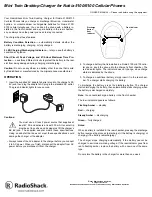
The GSM900, DCS, and PCS receiver inputs of RTR6275 are connected directly to the transceiver
front-end circuits(filters and antenna switch module). GSM900, DCS, and PCS receiver inputs use
differential configurations to improve common-mode rejection and second-order non-linearity
performance. The balance between the complementary signals is critical and must be maintained from
the RF filter outputs all the way into the IC pins
Since GSM900, DCS, and PCS signals are time-division duplex (the handset can only receive or
transmit at one time), switches are used to separate Rx and Tx signals in place of frequency duplexers -
this is accomplished in the switch module.
The GSM900, DCS, and PCS receive signals are routed to the RTR6275 through band selection filters
and matching networks that transform single-ended 50-Ω sources to differential impedances optimized
for gain and noise figure. The RTR input uses a differential configuration to improve second-order inter-
modulation and common mode rejection performance. The RTR6275 input stages include MSM-
controlled gain adjustments that maximize receiver dynamic range.
The amplifier outputs drive the RF ports of the quadrature RF-to-baseband downconverters.
The downconverted baseband outputs are multiplexed and routed to lowpass filters (one I and one Q)
having passband and stopband characteristics suitable for GMSK or 8-PSK processing. These filter
circuits include DC offset corrections. The filter outputs are buffered and passed on to the MSM6280 IC
for further processing (an interface shared with the RFR6275 UMTS receiver outputs
3. TECHNICAL BRIEF
- 20 -
Summary of Contents for U970
Page 1: ...Date April 2007 Issue 1 0 Service Manual Model U970 KU970 Service Manual U970 KU970 ...
Page 3: ... 4 ...
Page 20: ...3 TECHNICAL BRIEF 21 Fig 1 2 RTR6275 RX feature ...
Page 28: ...3 TECHNICAL BRIEF 29 Figure1 7 PM6650 Block Diagram ...
Page 41: ...3 TECHNICAL BRIEF 42 Table 1 1 Summary of MSM6280 device features ...
Page 45: ...3 TECHNICAL BRIEF 46 Figure 1 1 PM6650 Functional Block Diagram ...
Page 76: ...4 TROUBLE SHOOTING 77 4 1 RF CRF Component TOP SIDE BOTTOM SIDE 4 TROUBLE SHOOTING ...
Page 81: ...4 TROUBLE SHOOTING 82 Check C412 of PMIC U400 Check R214 of MSM U200 ...
Page 83: ...4 TROUBLE SHOOTING 84 Logic Table of the FEM ...
Page 89: ...4 TROUBLE SHOOTING 90 4 7 Checking GSM Block ...
Page 91: ...4 7 3 Checking RF Tx level 4 TROUBLE SHOOTING 92 ...
Page 94: ...4 TROUBLE SHOOTING 95 ...
Page 100: ...4 TROUBLE SHOOTING 101 R403 Q402 Q401 Q400 Charging part Main PCB Front ...
Page 103: ...4 TROUBLE SHOOTING 104 Q400 X 200 USB part 1 Main PCB Front U503 USB part 2 Main PCB Rear ...
Page 112: ...4 TROUBLE SHOOTING 113 CN601 CN701 CN700 ...
Page 115: ...4 TROUBLE SHOOTING 116 C500 C501 R501 R502 ...
Page 117: ...4 TROUBLE SHOOTING 118 SPK Audio Amplifier Analog Switch ...
Page 119: ...4 TROUBLE SHOOTING 120 MIC800 R507 C520 ...
Page 121: ...4 TROUBLE SHOOTING 122 R303 Ear_Sense_N C210 MIC Input ...
Page 141: ...5 DOWNLOAD 142 ...
Page 147: ...5 DOWNLOAD 148 Read IMEI BT address from UE 2 Step 4 Check IMEI and Bluetooth address ...
Page 158: ...6 BLOCK DIAGRAM 159 Table 2 1 RF Block Component ...
Page 163: ...6 BLOCK DIAGRAM 164 6 2 4 Placement Top Side ...
Page 164: ...6 BLOCK DIAGRAM 165 Bottom Side ...
Page 165: ... 166 ...
Page 175: ... 176 8 PCB LAYOUT U970 KU970 ...
Page 176: ... 177 8 PCB LAYOUT U970 KU970 ...
Page 177: ... 178 8 PCB LAYOUT U970 KU970 ...
Page 178: ... 179 8 PCB LAYOUT U970 KU970 ...
Page 179: ... 180 8 PCB LAYOUT ...
Page 180: ... 181 8 PCB LAYOUT ...
Page 181: ... 182 ...
Page 187: ... 188 ...
Page 189: ... 190 ...
Page 209: ...Note ...
Page 210: ...Note ...
















































